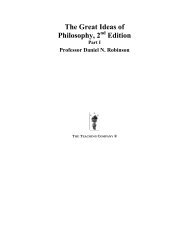English idioms in the first language and second language lexicon: a ...
English idioms in the first language and second language lexicon: a ...
English idioms in the first language and second language lexicon: a ...
You also want an ePaper? Increase the reach of your titles
YUMPU automatically turns print PDFs into web optimized ePapers that Google loves.
Beate Abel 345As <strong>the</strong> analysis of <strong>in</strong>formation ga<strong>in</strong>ed from <strong>the</strong> biographicalquestionnaire shows, nonnative speakers who are frequentlyexposed to <strong>idioms</strong> because <strong>the</strong>y read <strong>English</strong> literary texts everyday start to judge <strong>idioms</strong> as nondecomposable more often, just asnative speakers do. This is taken as evidence <strong>in</strong> favour of <strong>the</strong>underly<strong>in</strong>g representations, i.e., <strong>the</strong> existence of idiom entries.The fact that frequency has an effect on mental representationsis one of <strong>the</strong> most replicated results of many psychol<strong>in</strong>guisticexperiments. Therefore, its <strong>in</strong>tegration <strong>in</strong>to <strong>the</strong> DIR Model isnecessary <strong>and</strong> <strong>in</strong>dependently supported by <strong>the</strong>se studies. Here toomorphological studies provide fur<strong>the</strong>r evidence. For example,Caramazza et al. (1988), who postulated <strong>the</strong> Augmented AddressedMorphology Model for derived <strong>and</strong> <strong>in</strong>flected words, experimentallysupported a fundamental differentiation between frequent <strong>and</strong> lessfrequent words: whereas <strong>the</strong> former have word entries, <strong>the</strong> latterare decomposed <strong>in</strong>to <strong>the</strong>ir <strong>in</strong>dividual morphemes before access <strong>and</strong>comprehension take place. Similarly, Frauenfelder <strong>and</strong> Schreuder(1992) assumed <strong>in</strong> <strong>the</strong>ir Morphological Race Model thatmorphologically complex words are represented via <strong>the</strong>ir <strong>in</strong>dividualmorphemes but have <strong>the</strong>ir own entries as well. In process<strong>in</strong>g, bothrepresentations are activated. The frequency <strong>and</strong> transparency(decomposability) of <strong>the</strong> word be<strong>in</strong>g processed determ<strong>in</strong>e which‘route’ is quicker. Transparent, i.e., decomposable word forms of lowfrequency are accessed via <strong>the</strong> decomposition route whereas wordsof high frequency are accessed via <strong>the</strong>ir full entry, regardless of <strong>the</strong>irmorphological or semantic structure. A transfer of <strong>the</strong>se f<strong>in</strong>d<strong>in</strong>gs to<strong>idioms</strong> confirms <strong>the</strong> <strong>second</strong> assumption. An idiom’s frequencydeterm<strong>in</strong>es how it is represented. That is why decomposable <strong>idioms</strong>that are frequent enough can develop an idiom entry.Note that <strong>the</strong> <strong>second</strong> assumption is about frequency, notfamiliarity. How does <strong>the</strong> f<strong>in</strong>d<strong>in</strong>g that natives <strong>and</strong> nonnatives judgedecomposable <strong>idioms</strong> as more familiar fit <strong>in</strong> with <strong>the</strong> <strong>first</strong> <strong>and</strong><strong>second</strong> assumptions? It is argued here that familiarity <strong>and</strong>frequency refer to two dist<strong>in</strong>ct aspects. Frequency denotes an‘objective’ occurrence that can be statistically captured (Baayen,1992; 1993; Baayen <strong>and</strong> Lieber, 1997), while familiarity is a‘subjective’ measure, that cannot be determ<strong>in</strong>ed <strong>in</strong> a ma<strong>the</strong>maticalway. At <strong>the</strong> l<strong>in</strong>guistic or lexical level, where <strong>the</strong> <strong>first</strong> twoassumptions apply, frequency is relevant, whereas familiarity playsa role at <strong>the</strong> conceptual level. The difference between frequency<strong>and</strong> familiarity is reflected <strong>in</strong> <strong>the</strong> <strong>in</strong>structions given to <strong>the</strong>participants tak<strong>in</strong>g part <strong>in</strong> <strong>the</strong> studies <strong>in</strong> question. For example,Titone <strong>and</strong> Conn<strong>in</strong>e (1994: 255) have <strong>the</strong>ir participants rate <strong>the</strong>idiom’s mean<strong>in</strong>gfulness (‘how well you know <strong>the</strong> mean<strong>in</strong>g of <strong>the</strong>Downloaded from http://slr.sagepub.com at Shanghai Jiaotong University on March 7, 2009














